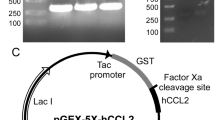Abstract
Objective
To obtain recombinant human CCL21 with biological activity from eukaryotic expression system for further use in cancer gene therapy.
Methods
A fragment of human CCL21 gene was obtained from pSK-hCCL21 plasmid digested by Xho I and BamH I, inserted into the responding sites of eukaryotic expression vector pVAX1, and then transfected into COS-7 cells by electroporation method. The expression of hCCL21 protein was detected by western blotting analysis. The in vitro chemotaxis assay was used to test the chemotactic function of the expression product to lymphocytes.
Results
Human CCL21 protein was expressed by transfected COS-7 cells with recombinant plasmid containing hCCL21 gene, and was verified by western blotting. The in vitro chemotaxis assay demonstrated that human CCL21 protein had a potent chemotactic function to lymphocytes.
Conclusion
Human CCL21 was successfully and transiently expressed in eukaryotic cells, which lays some foundation for the study of CCL21 gene therapy in murine tumor models.
Similar content being viewed by others
References
Cyster J. Chemokines and the homing of dendritic cells to the T cell areas of lymphoid organs[J]. J Exp Med 1999; 189: 447–450.
Riedl K, Baratelli F, Batra RK, et al. Overexpression of CCL-21/Secondary Lymphoid Tissue Chemokine in human Dendritic Cells Augments Chemotactic Activities for Lymphocytes and Antigen Presenting Cells[J]. Mol Cancer 2003; 2: 35–48.
Sambrook J, Fritsch E F, Maniatis T. Molecular Cloning: A Laboratory Manual[M]. 2nd ed. New York: Cold Spring Harbor Laboratory Press 1989; 9:880.
Elizabeth A, Baker, Michael W, et al. Choices in Transfection Methodologies: Transfection Efficiency Should Not Be the Sole Criterion[J]. Focus 2000; 22: 30–32.
Mitchell A, Dass CR, Sun LQ, et al. Inhibition of human breast carcinoma proliferation, migration, chemoinvasion and solid tumor growth by DNAzymes targeting the zine Finger transcription factor EGR-1[J]. Nucleic Acids Res 2004; 32:10 3065–10 3069.
Guo JQ, Chen L, Ai HW, et al. A novel fusion protein of IP10-seFv retains antibody specificity and chemokine function[J]. Biochem Biophys Res Commun 2004; 320:506–513.
Gunn M D, Tangemann K, Tam C, et al. A chemokine expressed in lymphoid high endothelial venules promotes the adhesion and chemotaxis of naive T lymphocytes[J]. Proc Natl Acad Sci USA. 1998; 95: 258–263.
Kirk CJ, Hartigan OD, Nickoloff BJ, et al. T Cell-dependent Antitumor Immunity Mediated by Secondary Lymphoid Tissue Chemokine Augmentation of Dendritic Cell-based Immunotherapy[J]. Cancer Res 2001; 61:2062–2070.
Zlotnik A, Yoshie O. Chemokines: a new classification system and their role in immunity[J]. Immunity 2000; 12:121–127.
Moretta A. Natural killer cells and dendritic cells: rendezvous in abused tissues[J]. Nat Rev Immunol 2002; 2: 957–965.
Takeuchi H, Fujimoto A, Tanaka M, et al. CCL21 Chemokine Regulates Chemokine Receptor CCR7 Bearing Malignant Melanoma Cells[J]. Clin Cancer Res 2004; 10: 2351–2358.
Yang SC, Hillinger S, Riedl K, et al. Intratumoral Administration of Dendritic Cells Overexpressing CCL21 Generates Systemic Antitumor Responses and Confers Tumor Immunity[J]. Clin Cancer Res 2004; 10:2891–2901.
Sharma S, Stolina M, Zhu L, et al. Secondary Lymphoid Organ Chemokine Reduces Pulmonary Tumor Burden in Spontaneous Murine Bronchoalveolar Cell Carcinomal[J]. Cancer res 2001; 61: 6406–6412.
Sharma S, Stolina M, Luo J, et al. Secondary lymphoid tissue chemokine mediates T cell-dependent antitumor responses in vivo[J]. J Immunol 2000; 164: 4558–4563.
Arenberg DA, Zlotnick A, Strom SRB, Burdick MD, Strieter RM. The murine CC chemokine, 6-Ckine, inhibits tumor growth and angiogenesis in a human lung cancer SCID mouse model[J]. Cancer Immunol Immunother 2000; 49: 587–592.
Author information
Authors and Affiliations
Corresponding author
Additional information
Foundation item: This work was supported by the National Natural Science Foundation of China (No. 3037304).
Biography: HOU Li (1974–), female, master of medicine, physician, Medical Research Center, Shangdong Province Hospital, Shandong University.
Rights and permissions
About this article
Cite this article
Hou, L., Liu, Q., Jiao, Yl. et al. Construction of eukaryotic expression vector for human CCL21 and characterization of its chemotactic activity. Chin. J. Cancer Res. 18, 246–250 (2006). https://doi.org/10.1007/s11670-006-0246-z
Received:
Accepted:
Issue Date:
DOI: https://doi.org/10.1007/s11670-006-0246-z




